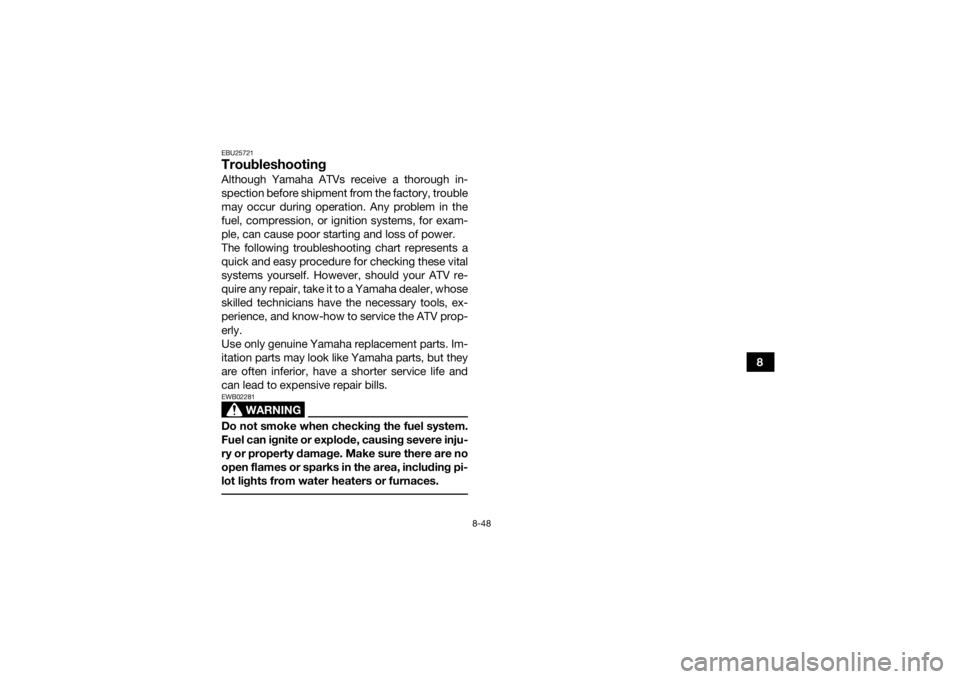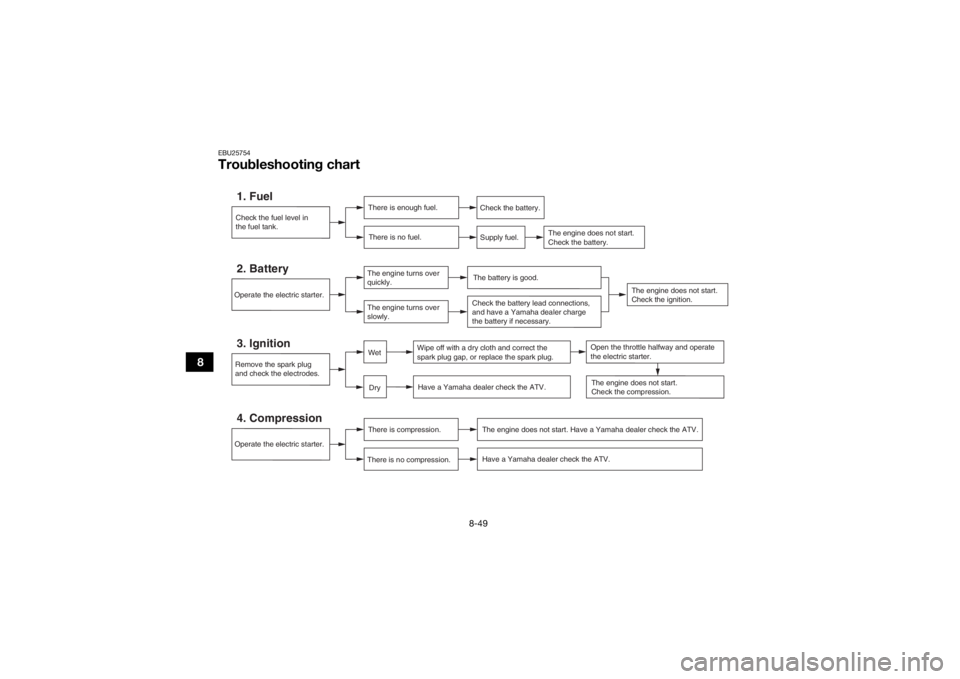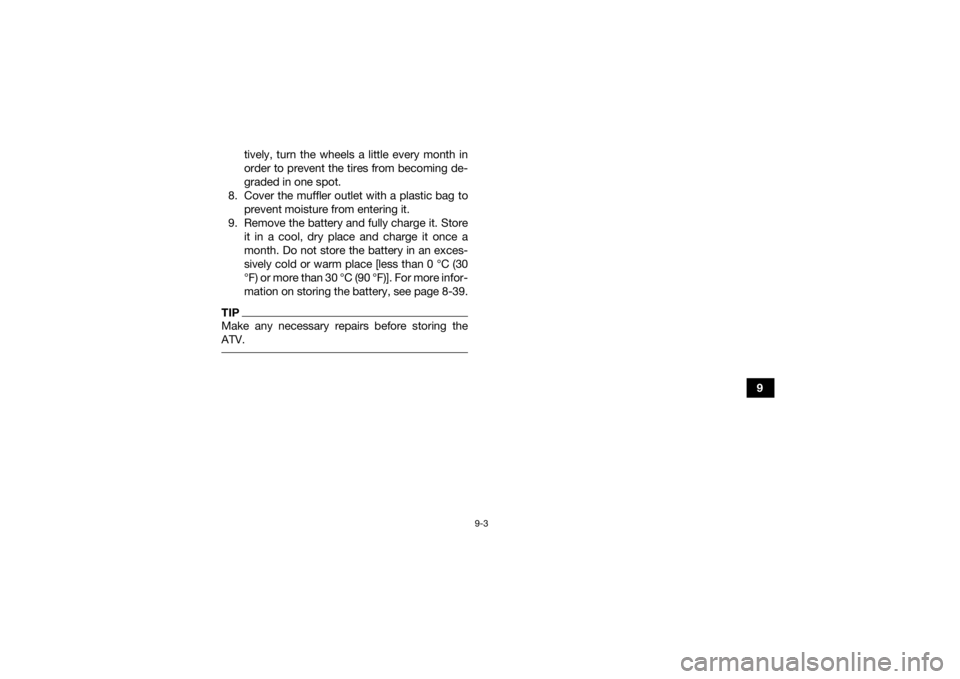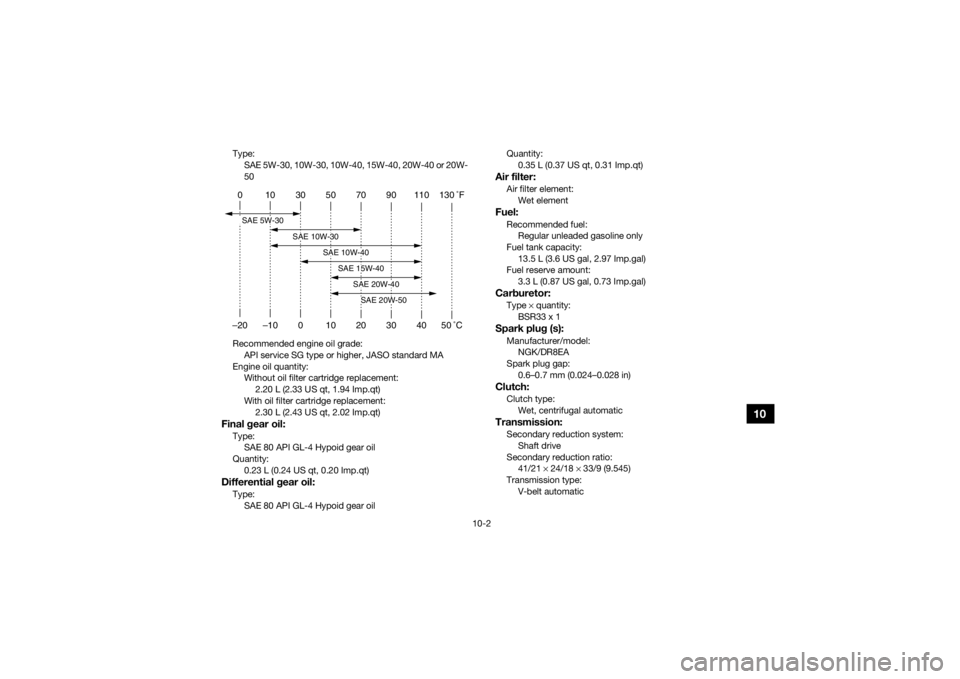YAMAHA GRIZZLY 350 2016 Owners Manual
Manufacturer: YAMAHA, Model Year: 2016, Model line: GRIZZLY 350, Model: YAMAHA GRIZZLY 350 2016Pages: 146, PDF Size: 3.35 MB
Page 131 of 146

8-48
8
EBU25721TroubleshootingAlthough Yamaha ATVs receive a thorough in-
spection before shipment from the factory, trouble
may occur during operation. Any problem in the
fuel, compression, or ignition systems, for exam-
ple, can cause poor starting and loss of power.
The following troubleshooting chart represents a
quick and easy procedure for checking these vital
systems yourself. However, should your ATV re-
quire any repair, take it to a Yamaha dealer, whose
skilled technicians have the necessary tools, ex-
perience, and know-how to service the ATV prop-
erly.
Use only genuine Yamaha replacement parts. Im-
itation parts may look like Yamaha parts, but they
are often inferior, have a shorter service life and
can lead to expensive repair bills.
WARNING
EWB02281Do not smoke when checking the fuel system.
Fuel can ignite or explode, causing severe inju-
ry or property damage. Make sure there are no
open flames or sparks in the area, including pi-
lot lights from water heaters or furnaces. U1NS64E0.book Page 48 Thursday, June 25, 2015 8:36 AM
Page 132 of 146

8-49
8
EBU25754Troubleshooting chart
Check the fuel level in
the fuel tank.1. Fuel
There is enough fuel.There is no fuel.
Check the battery.
Supply fuel.
The engine does not start.
Check the battery.
The engine does not start.
Check the ignition.
Operate the electric starter.4. Compression
There is compression.
There is no compression.
The engine does not start. Have a Yamaha dealer check the ATV.Have a Yamaha dealer check the ATV.
Remove the spark plug
and check the electrodes.3. Ignition
Wipe off with a dry cloth and correct the
spark plug gap, or replace the spark plug. Have a Yamaha dealer check the ATV.
The engine does not start.
Check the compression.
Operate the electric starter.2. Battery
The engine turns over
quickly.
The engine turns over
slowly.
The battery is good.Check the battery lead connections,
and have a Yamaha dealer charge
the battery if necessary.
DryWet
Open the throttle halfway and operate
the electric starter.
U1NS64E0.book Page 49 Thursday, June 25, 2015 8:36 AM
Page 133 of 146

9-1
9
EBU25861
CLEANING AND STORAGE
EBU25882CleaningFrequent, thorough cleaning of your ATV will not
only enhance its appearance but will improve its
general performance and extend the useful life of
many components.1. Before cleaning the ATV: a. Block off the end of the exhaust pipe toprevent water entry. A plastic bag and
strong rubber band may be used.
b. Make sure the spark plug and all filler caps are properly installed.
2. If the engine case is excessively greasy, apply degreaser with a paint brush. Do not apply
degreaser to the wheel axles.
3. Rinse the dirt and degreaser off with a garden hose. Use only enough pressure to do the
job. WARNING! Wet brakes may have re-
duced stopping ability, increasing the
chance of an accident. Test the brakes af-
ter washing. Apply the brakes several
times at slow speeds to let friction dry out
the linings.
[EWB02312]
NOTICE: Excessive wa-
ter pressure may cause water seepage and deterioration of wheel bearings,
brakes, transmission seals and electrical
devices. Many expensive repair bills have
resulted from improper high-pressure de-
tergent applications such as those avail-
able in coin-operated car washers.
[ECB00712]
4. Once most of the dirt has been hosed off,
wash all surfaces with warm water and mild,
detergent-type soap. An old toothbrush or
bottle brush is handy for hard-to-reach pla-
ces.
5. Rinse the ATV off immediately with clean wa- ter and dry all surfaces with a chamois, clean
towel or soft absorbing cloth.
6. Clean the seat with a vinyl upholstery cleaner to keep the cover pliable and glossy.
7. Automotive type wax may be applied to all painted and chrome plated surfaces. Avoid
combination cleaner-waxes. Many contain
abrasives which may mar the paint or protec-
tive finish. When finished cleaning, start the
engine and let it idle for several minutes.
U1NS64E0.book Page 1 Thursday, June 25, 2015 8:36 AM
Page 134 of 146

9-2
9
EBU25934StorageShort-term
Always store your ATV in a cool, dry place and, if
necessary, protect it against dust with a porous
cover. NOTICE: Storing the ATV in a poorly ven-
tilated room or covering it with a tarp while it is
still wet, will allow water and humidity to seep
in and cause rust. To prevent corrosion, avoid
damp cellars, stables (because of the presence
of ammonia) and areas where strong chemi-
cals are stored.
[ECB00722]
Long-term
Before storing your ATV for several months: 1. Follow all the instructions in the “Cleaning” section of this chapter.
2. Turn the fuel cock lever to “OFF”.
3. Drain the carburetor float chamber by loosen- ing the drain bolt; this will prevent fuel depos-
its from building up. Pour the drained fuel into
the fuel tank.
4. Fill up the fuel tank and add fuel stabilizer (if available) to prevent the fuel from deteriorat-
ing. 5. Perform the following steps to protect the cyl-
inder, piston rings, etc. from corrosion.a. Remove the spark plug cap and spark plug.
b. Pour a teaspoonful of engine oil into the spark plug bore.
c. Install the spark plug cap onto the spark plug, and then place the spark plug on the
cylinder head so that the electrodes are
grounded. (This will limit sparking during
the next step.)
d. Turn the engine over several times with the starter. (This will coat the cylinder wall
with oil.)
e. Remove the spark plug cap from the spark plug, and then install the spark plug and
the spark plug cap.
6. Lubricate all control cables and the pivoting points of all levers and pedals.
7. Check and, if necessary, correct the tire air pressure, and then block up the ATV so that
all of its wheels are off the ground. Alterna-
Specified amount:
7.5 ml of stabilizer to each liter of fuel (or 1
oz of stabilizer to each gallon of fuel)U1NS64E0.book Page 2 Thursday, June 25, 2015 8:36 AM
Page 135 of 146

9-3
9
tively, turn the wheels a little every month in
order to prevent the tires from becoming de-
graded in one spot.
8. Cover the muffler outlet with a plastic bag to prevent moisture from entering it.
9. Remove the battery and fully charge it. Store it in a cool, dry place and charge it once a
month. Do not store the battery in an exces-
sively cold or warm place [less than 0 °C (30
°F) or more than 30 °C (90 °F)]. For more infor-
mation on storing the battery, see page 8-39.
TIPMake any necessary repairs before storing the
ATV. U1NS64E0.book Page 3 Thursday, June 25, 2015 8:36 AM
Page 136 of 146

10-1
10
EBU25962
SPECIFICATIONS
Dimensions:Overall length:1984 mm (78.1 in)
Overall width: 1085 mm (42.7 in)
Overall height:
1120 mm (44.1 in)
Seat height: 827 mm (32.6 in)
Wheelbase: 1233 mm (48.5 in)
Ground clearance:
245 mm (9.6 in)
Minimum turning radius: 3000 mm (118 in)Weight:Curb weight:
255.0 kg (563 lb)Noise and vibration level:Noise level (77/311/EEC):77.6 dB(A) (EUR,FRA,GBR)
Uncertainty of measurement:
3.0 dB(A) (EUR,FRA,GBR)
Vibration on seat (EN1032, ISO5008): Will not exceed 0.5 m/s² (EUR,FRA,GBR)
Uncertainty of measurement: 0.2 m/s² (EUR,FRA,GBR) Vibration on handle (EN1032, ISO5008):
2.8 m/s² (EUR,FRA,GBR)
Uncertainty of measurement: 0.7 m/s² (EUR,FRA,GBR)
Engine:Engine type:
Air cooled 4-stroke, SOHC
Cylinder arrangement: Single cylinder
Displacement: 348 cm³
Bore × stroke:
83.0 × 64.5 mm (3.27 × 2.54 in)
Compression ratio: 9.2 : 1
Starting system: Electric starter
Lubrication system:
Wet sumpEngine oil:Recommended brand:YAMALUBE
U1NS64E0.book Page 1 Thursday, June 25, 2015 8:36 AM
Page 137 of 146

10-2
10
Type:SAE 5W-30, 10W-30, 10W-40, 15W-40, 20W-40 or 20W-
50
Recommended engine oil grade: API service SG type or higher, JASO standard MA
Engine oil quantity: Without oil filter cartridge replacement:2.20 L (2.33 US qt, 1.94 Imp.qt)
With oil filter cartridge replacement: 2.30 L (2.43 US qt, 2.02 Imp.qt)Final gear oil:Type:SAE 80 API GL-4 Hypoid gear oil
Quantity: 0.23 L (0.24 US qt, 0.20 Imp.qt)Differential gear oil:Type:SAE 80 API GL-4 Hypoid gear oil Quantity:
0.35 L (0.37 US qt, 0.31 Imp.qt)
Air filter:Air filter element:
Wet elementFuel:Recommended fuel:Regular unleaded gasoline only
Fuel tank capacity:
13.5 L (3.6 US gal, 2.97 Imp.gal)
Fuel reserve amount: 3.3 L (0.87 US gal, 0.73 Imp.gal)Carburetor:Type × quantity:
BSR33 x 1Spark plug (s):Manufacturer/model: NGK/DR8EA
Spark plug gap:
0.6–0.7 mm (0.024–0.028 in)Clutch:Clutch type:Wet, centrifugal automaticTransmission:Secondary reduction system:Shaft drive
Secondary reduction ratio: 41/21 × 24/18 × 33/9 (9.545)
Transmission type:
V-belt automatic
0 10 30 50 70 90 110 130 �F
–20 –10 0 10 20 30 40 50 �CSAE 5W-30
SAE 10W-30
SAE 10W-40
SAE 15W-40
SAE 20W-40SAE 20W-50
U1NS64E0.book Page 2 Thursday, June 25, 2015 8:36 AM
Page 138 of 146

10-3
10
Operation:Left hand operation
Forward gear: 35/20 (1.750)
Reverse gear:
26/15 (1.733)Chassis:Frame type:Steel tube frame
Caster angle:
4.00 °
Trail: 21.0 mm (0.8 in)Front tire:Type:
Tubeless
Size: AT25 x 8-12
Manufacturer/model: CHENG SHIN/C-828 (AUS,NZL)
MAXXIS/MU13 (EUR,FRA,GBR)Rear tire:Type:
Tubeless
Size: AT25 x 10-12
Manufacturer/model: CHENG SHIN/C-828 (AUS,NZL)
MAXXIS/MU14 (EUR,FRA,GBR)
Loading:Maximum loading limit:210.0 kg (463 lb)
(Total weight of rider, cargo, accessories, and tongue)Tire air pressure (measured on cold tires):Recommended:
Front: 25.0 kPa (0.250 kgf/cm², 3.6 psi)
Rear:
25.0 kPa (0.250 kgf/cm², 3.6 psi)
Minimum: Front:
22.0 kPa (0.220 kgf/cm², 3.2 psi)
Rear: 22.0 kPa (0.220 kgf/cm², 3.2 psi)Front wheel:Wheel type:
Panel wheel
Rim size: 12 x 6.0ATRear wheel:Wheel type:
Panel wheel
Rim size: 12 x 7.5ATFront brake:Type:
Disc brake
Operation: Right hand operation
U1NS64E0.book Page 3 Thursday, June 25, 2015 8:36 AM
Page 139 of 146

10-4
10
Specified brake fluid:DOT 4Rear brake:Type:
Drum brake
Operation: Left hand and right foot operationFront suspension:Type:
Double wishbone
Spring/shock absorber type: Coil spring/oil damper
Wheel travel: 160 mm (6.3 in)Rear suspension:Type:Swingarm
Spring/shock absorber type: Coil spring/oil damper
Wheel travel:
180 mm (7.1 in)Electrical system:Ignition system:DC CDI
Charging system:
AC magnetoBattery:Model:YTX14AH
Voltage, capacity:
12 V, 12.0 Ah
Headlight:Bulb type:Krypton bulbBulb voltage, wattage × quantity:Headlight:
12 V, 30.0/30.0 W × 2
Tail/brake light: 12 V, 5.0/21.0 W × 1
Meter lighting:
14 V, 3.0 W × 1
Neutral indicator light: 12 V, 1.7 W × 1
Reverse indicator light: 12 V, 1.7 W × 1
Oil temperature warning light:
12 V, 1.7 W × 1
On-command four-wheel-drive indicator light: 12 V, 1.7 W × 1Fuses:Main fuse:
30.0 A
Headlight fuse: 15.0 A
Signaling system fuse: 10.0 A
Ignition fuse:
15.0 A
Auxiliary DC jack fuse: 10.0 A
Four-wheel-drive motor fuse: 3.0 A
U1NS64E0.book Page 4 Thursday, June 25, 2015 8:36 AM
Page 140 of 146

10-5
10
EBU30402For Europe only
The figures quoted are emission levels and are not
necessarily safe working levels. Whilst there is a
correlation between the emission and exposure
levels, this cannot be used reliably to determine
whether or not further precautions are required.
Factors that influence the actual level of exposure
of work-force include the characteristics of the
work room, the other sources of noise, etc. i.e. the
number of machines and other adjacent process-
es, and the length of time for which an operator is
exposed to the noise. Also the permissible expo-
sure level can vary from country. This information,
however, will enable the user of the machine to
make a better evaluation of the hazard and risk.U1NS64E0.book Page 5 Thursday, June 25, 2015 8:36 AM